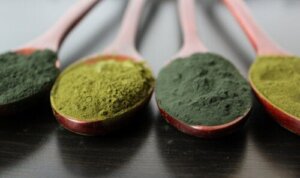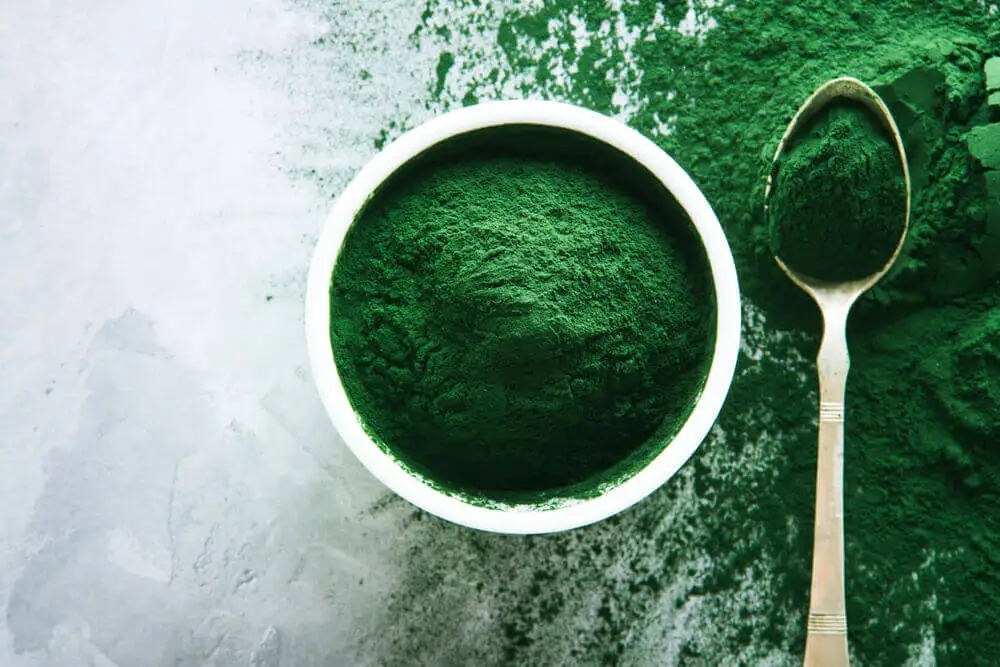Algae Protein Powder: All You Need to Know About this Supplement


Written and verified by the nutritionist Maria Patricia Pinero Corredor
Algae are aquatic organisms, similar to plants, in that they’re capable of photosynthesis. However, they don’t have roots, stems, or leaves. Most people know them from being in the water, although they may not know that they’re also edible. From a nutritional point of view, they have a lot to contribute. So, stay with us as we talk about algae protein powder.
Algae protein is a supplement marketed as having several properties, such as a high content of vitamins, minerals, and amino acids. Here we’ll study this product in more depth, together with its advantages, contraindications, and recommendations for consumption.
Nutritional value of algae
Algae has high nutritional value, although this depends on the species of algae. There are 27,000 species in the world, and only 50 are suitable for human consumption.
However, what they all have in common is a high protein content, which makes them a complete food. In addition, they provide vitamins and fiber with low fat content.
Let’s take a closer look at the nutritional value of seaweed in general, as when it’s turned into powder, most of these nutrients are kept.
A good source of protein
Seaweed is a source of protein of high biological value. The protein content can range from 10 to 30% when converted into powder.
Amino acids vary according to the species. In general, non-essential amino acids such as glycine, arginine, alanine, glutamic acid, and cystine predominate.
Red algae, in particular, are also sources of taurine, an amino acid that can be considered essential. Lysine is the essential amino acid that predominates in algae.
The high content of vitamins and minerals
In addition, algae are a source of vitamins A, B1, B12, C, D and E, riboflavin, niacin, pantothenic acid and folic acid. To this, we can add the great content in minerals, and it’s one of the food sources with the highest amounts.
100 grams (4 oz) of powdered seaweed can provide between 12 and 42 grams (0.5 to 2 oz) of minerals. These include calcium, iodine, iron, magnesium, phosphorus, molybdenum, and manganese.

The fat content of algae is low, between 1% and 5%. However, among the lipids it does contain, there’s a high proportion of essential fatty acids. They synthesize long-chain polyunsaturated fatty acids, such as eicosapentaenoic acid (EPA) and docosahexaenoic acid (DHA).
Red algae have high EPA, palmitic, oleic, and arachidonic acid contents. Brown algae, on the other hand, have large amounts of omega-9, omega-3 and omega-6, although they’re low in EPA.
Green algae have more essential fatty acids, such as linoleic and alpha-linolenic. Others present are palmitic, oleic and DHA.
Read more: Discover the Benefits of Seaweed for Hypothyroidism
Carbohydrate and fiber content
The carbohydrate content ranges from 42% to 76%. They comprise soluble carbohydrates, agar, carrageenans, pectins, and sugars.
The proportion of fiber content in seaweeds can vary, depending on the species. Although, on average, they have 25 grams per 100 grams of fiber, being mostly of the soluble type.
Nutritional value of spirulina
The most commonly used algae is spirulina, although any other edible algae can be converted into powder. Its composition is as follows:
- Lipids: 6%
- Ashes: 6.4%
- Humidity: 4%
- Proteins: 60%
- Crude fiber: 0,1%
- Carbohydrates: 13%
- Chlorophyll: 6.10 grams per kilo
The benefits of algae protein powder
Despite the fact that algae has a multitude of compounds, we’ll concentrate on the specific benefits of protein, which makes up 60% of its nutritional value.
Highly digestible
Algae are simple photosynthetic organisms that contain nutrients that are easily digested and absorbed. In addition, they cause little gastric discomfort compared to other types of protein.
It has been found in comparative studies that the protein present in algae is better digested than whey protein, which is another important protein. In another study it was shown that cooking and drying do not affect the concentration of amino acids.
May contain important amino acids
It’s important to note that red algae contain taurine. This amino acid is present in most tissues.
Taurine is involved in the physiological processes of osmoregulation, membrane stabilization, immune system processes, eye, and nervous system development.
Taurine is found in few foods. The main one that contains it is breast milk, and so it isn’t easily found by adults.
Brown algae, on the other hand, contain phosphoserine. This is a stimulant of mental functions, which improves memory and learning. In addition, it increases concentration under stress. It’s also able to prevent and slow age-related brain deterioration.
It can act as an antioxidant and anti-inflammatory
Among the proteins in seaweed, there are two groups, called lectins and phycobiliproteins, according to research. Lectins bind with carbohydrates and participate in biological processes of intercellular communication. They also have antibacterial, antiviral, and anti-inflammatory functions.
Phycobiliproteins are protein-pigment complexes that impart antioxidant properties and could be beneficial in the prevention or treatment of diseases associated with oxidative stress.
They’re also known to have other derived compounds, which could be involved in biological functions, such as antihypertensive, immunomodulatory, antithrombotic, antioxidant, and antimicrobial actions, in addition to being used as nutrients.
Can increase muscle mass
Protein supplements help to increase strength and muscle mass. So it’s necessary to ingest protein in the context of a training plan.
Taking seaweed protein powder supplement is useful for athletes.
Possible contraindications of algae protein powder
Phenylalanine is an amino acid that’s present in seaweed. There’s a warning for people suffering from phenylketonuria.
Patients with this condition can’t break down this amino acid and it accumulates in the body. When the disease isn’t treated, it can cause intellectual disability, brain damage, and seizures.

Read more: 5 Precautions and Contraindications when Taking Spirulina
How to take algae protein powder?
You should know that algae protein powder has a strong, bitter, and salty taste, which means that you should try to contrast it. It can be taken by putting a spoonful in juices, yogurts, smoothies, or other liquid foods.
It’s recommended at breakfast, accompanied by the following ingredients:
- Yogurt
- Oatmeal
- Rice
- Salads
- Soups and broths
- Soy smoothie
To start taking it, you should consume between 500 milligrams or 1 gram, 1 to 3 times a day. It’s always advisable to consult with a medical specialist to adjust the dose to your requirements.
All cited sources were thoroughly reviewed by our team to ensure their quality, reliability, currency, and validity. The bibliography of this article was considered reliable and of academic or scientific accuracy.
- Avigad. Spirulina Platensis Arthrospira: Physiology, Cell-Biology And Biotechnology 1st Edición. 1997. Disponible en https://www.amazon.com/-/es/Avigad-Vonshak/dp/0748406743
- Vilma Quitral R.(1) Carla Morales G. (2) Marcela Sepúlveda L.(2) Marco Schwartz M. (2). Propiedades nutritivas y saludables de algas marinas y su potencialidad como ingrediente funcional.Rev Chil Nutr Vol. 39, N° 4, Diciembre 2012, pp.: 196-202.
- Fujiwara-Arasaki T, Mino N, Kuroda M. The protein value in human nutrition of edible marine algae in Japan. Hydrobiologia. 1984;116/117:513–516. doi: 10.1007/BF00027735.
- Mark L. Wells. Algae as nutritional and functional food sources: revisiting our understanding. J Appl Phycol. 2017; 29(2): 949–982. Published online 2016 Nov 21.
- Cañas P. ROL BIOLÓGICO Y NUTRICIONAL DE LA TAURINA Y SUS DERIVADOS. Rev. chil. nutr. v.29 n.3 Santiago dic. 2002. http://dx.doi.org/10.4067/S0717-75182002000300003
- J F Collet. Mechanistic studies of phosphoserine phosphatase, an enzyme related to P-type ATPases. J Biol Chem. 1999 Nov 26;274(48):33985-90. doi: 10.1074/jbc.274.48.33985.
- Nagai, Nadia Florencia. Estudio de harinas de algas marinas comestibles y su incorporación en productos cárnicos. 2018. http://sedici.unlp.edu.ar/handle/10915/73022
-
Kim, S.K. and Wijesekara, I. (2010) Development and Biological Activities of Marine-Derived Bioactive Peptides: A Review. Journal of Functional Foods, 2, 1-9. http://dx.doi.org/10.1016/j.jff.2010.01.003
- Jaime Ortiz. Laboratorio de Química y Análisis de Alimentos, Departamento de Ciencia
de los Alimentos y Tecnología Química. Composición Nutricional y Funcional de Algas Rodofíceas Chilenas. 2011. Disponible en: https://repositorio.uchile.cl/bitstream/handle/2250/121460/Monografia%20II%20algas%20Rojas.pdf?sequence=1
This text is provided for informational purposes only and does not replace consultation with a professional. If in doubt, consult your specialist.








